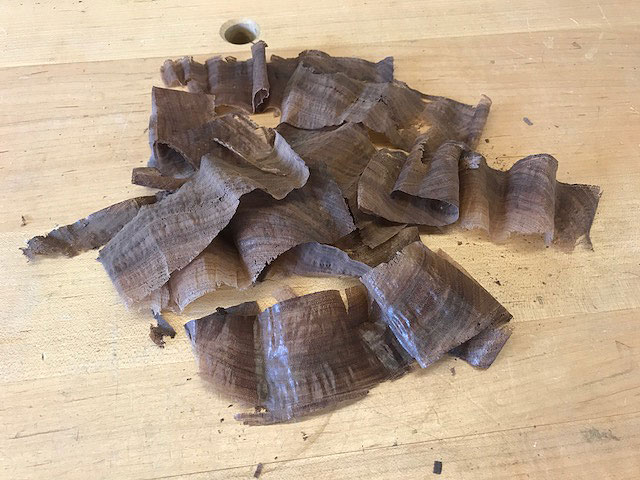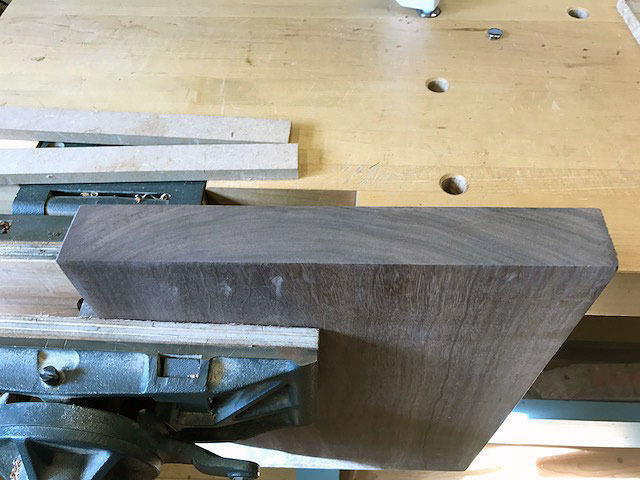Friedrich":lj5biys2 said:
I'm now after a blockplane (for endgrain/edge trimming & other odd trimming jobs)
Block planes tend to be the Miscellaneous File of the plane world. If there's a job that doesn't feel right for a bench plane then you'll often pick up the block plane instead. In reality I find they get used for two very different groups of tasks, and indeed you suggest as much in your question.
The first group is "trimming" tasks. This can be things like flushing off the overhanging edge of Formica or iron-on Melamine edge stripping, chamfering the ends of legs, or trimming back a dowel peg so it's flush with the surrounding surface. These are all jobs where a normal bench plane would feel unwieldy and, as you may be planing away from your bench vice, it's often a benefit to hold the workpiece with one hand and use the block plane single handed. If you're dealing with plastic laminates or end grain then a low blade angle is an advantage, but if you're dealing with long grain, hardwood trimming tasks then you'll probably want a higher pitch to prevent tear out. You don't need two separate block planes for this, just a second iron with a different bevel angle. I use a lot of inlaid stringing in my furniture and I'll generally use a block plane with a high angle blade to cut back the proud stringing before final flushing off with a card scraper. On delicate planing jobs like these a block plane is ideal, a regular bench plane would obscure the workpiece so you wouldn't know exactly where you're cutting.

The second job that many people associate with block planes is end grain planing. But here the story's more complicated. Any experienced woodworker will admit that they'll go to almost any lengths to avoid or minimise end grain planing. It's hard on you and it's even harder on your tools. Consequently you'll saw end grain, or use a disc or a belt sander, anything in fact to minimise planing. But there's no escaping it, sooner or later you will have to plane end grain. Because it's such hard graft you'll ideally secure the workpiece in a vice and set to with the biggest bench plane that's realistic. You want a solid two handed grip and you want the heft and momentum of a heavy plane. You would
prefer a low angle blade, but you'll prioritise a two handed grip because end grain planing is just so strenuous.
Unfortunately you may well be out of luck. Oftentimes you'll be faced with planing the ends of a big table top that's too long to fasten vertically in your vice. Or you'll have 65mm x 65mm table leg or bed post sections, where the end grain needs planing, and if the piece is already assembled you can't always secure it firmly. These are the worst planing jobs there are, and because I'm doing them pretty regularly I equip myself with a range of low angle planes,
Normally I'm a proponent of Stanley and Record planes, I think the current trend towards ultra thick plane irons is a bit over done and for many woodworkers it isn't really necessary. But when it comes to end grain planing I've found that the new generation of A2 and PM-V11 steels really come into their own. It's not that traditional Stanley or Record blades
can't slice through end grain, they can, but they blunt extremely quickly, which makes it even more arduous to push them through the timber, and makes an unfastened workpiece even more prone to skipping around the workshop.
Another point to consider is that for many DIY-ers, a block plane might be the only plane they owned. Particularly in the early post war and inter war periods, when money was even tighter than today, it prompted Stanley and Record to produce the cheapest possible block planes. These economy variants are amongst the worst tools I've ever handled, don't waste your money on them!
To summarise, for trimming jobs a top of the range Stanley or Record low angle block plane is fine, but get a second iron so you've both high/standard angle as well as low angle. For end grain planing firstly take care to minimise the scale of the challenge, then fasten the work very firmly, and then use a regular bench plane but be prepared to hone the edge frequently. If however more awkward end grain planing will be a regular challenge for you, then spend the money and get yourself a Lie Nielsen or Veritas tool.
Good luck!








































